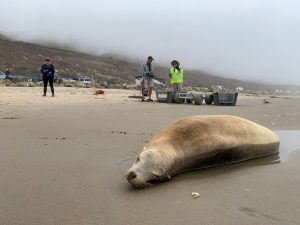Effort launched to expand, formalize HABs monitoring in coastal waters

SCCWRP and its partners are launching an effort to expand and formalize Southern California’s capacity to collect monitoring data on toxin-producing harmful algal blooms (HABs) in coastal waters – an initiative aimed at getting key data sets into the hands of managers and others when they need this information most.
The effort, which kicks off this spring, will develop a written HABs strategic response plan that enables the multiple researchers and agencies that monitor coastal HABs offshore to rapidly mobilize to initiate coordinated monitoring at the first signs of bloom events. The plan also will focus on improving the speed at which HABs monitoring data become available through California’s 17-year-old Harmful Algal Bloom Monitoring and Alert Program (HABMAP) – a statewide monitoring program co-developed by SCCWRP that collects HABs data via weekly sampling at piers.
During major bloom events over the past decade, thousands of sea lions and other marine mammals have become stranded en masse at beaches as a result of poisoning by domoic acid, which is the toxin produced by a type of HAB known as Pseudo-nitzschia.
For mammal rescue organizations to mount an effective response during these seasonal bloom events, they need to know as soon as possible when a toxin-producing bloom event is starting. These organizations, mostly made up of volunteers, are often outnumbered during sudden, dramatic spikes in marine mammal strandings on beaches. Generally, about 40%-60% of all stranded mammals that are rescued can recover if administered appropriate anti-seizure medications and/or moved from populated beaches to local rehabilitation centers.
While HABMAP has long been generating foundational HABs data at pier sites statewide, there can be a lag time of a month or more for HABMAP data to be analyzed and made publicly available, limiting the data’s utility for real-time management decision-making, particularly for marine mammal rescue centers.
Moreover, recent HABs monitoring investigations have found that targeting HABs monitoring at piers only is inadequate to serve as an early-warning indicator of larger-scale bloom events that can start further offshore, particularly Pseudo-nitzschia, which is among the most ubiquitous types of HABs in Southern California coastal waters. The reasons is that it can take days to weeks after a bloom starts for the bloom to be reflected in HABMAP pier data – a consequence of the fact that Pseudo-nitzschia blooms often begin offshore, causing the pier-based monitoring to miss the start of these events.
The written HABs strategic response plan will focus on formalizing networks of partners that can rapidly mobilize to collect offshore field sampling data as soon as a bloom event starts. In recent years, researchers and managers have come together in an informal, ad-hoc fashion to initiate offshore monitoring during bloom events.
To improve the speed at which HABMAP monitoring data become available, researchers will focus on updating monitoring methods to more rapidly and easily detect domoic acid at lower levels. The newer methods – which are better suited to running small batches of samples more frequently than the commonly used method – have the potential to shorten sample analysis turnaround times from months to days.
The written HABs strategic response plan will be initially piloted in Southern California during the next seasonal HABs event. Long term, researchers’ goal is to expand the monitoring plan statewide.
For more information or to get involved, contact Dr. Jayme Smith.
More news related to: Eutrophication, Harmful Algal Blooms, Regional Monitoring, Top News